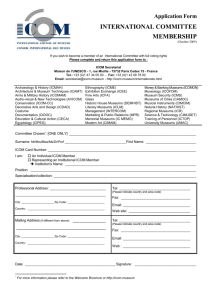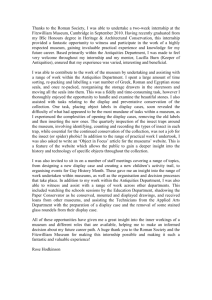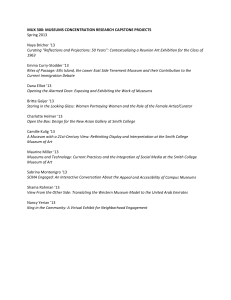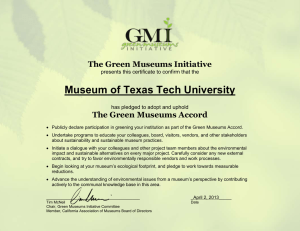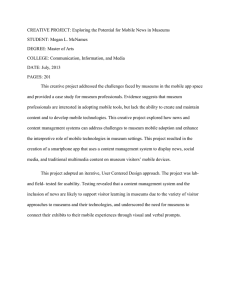Red List of Syrian Cultural Objects at Risk
advertisement
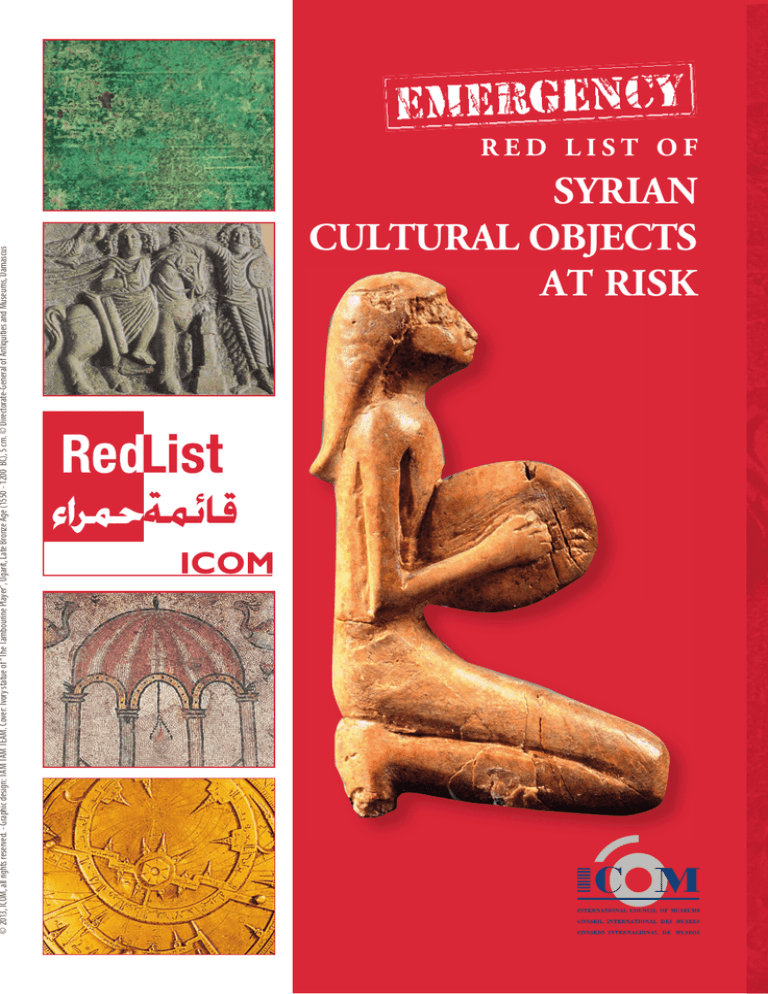
© 2013, ICOM, all rights reserved. - Graphic design: TAM TAM TEAM. Cover: Ivory statue of “The Tambourine Player”, Ugarit, Late Bronze Age (1550 - 1200 BC), 5 cm. © Directorate-General of Antiquities and Museums, Damascus RED LIST OF SYRIAN CULTURAL OBJECTS AT RISK The cultural heritage of Syria is protected by the following national and international laws: NATIONAL LEGISLATION INTERNATIONAL INSTRUMENTS Decree-Law No. 84 of the Civil Code regarding archaeological objects covered by specific laws (18 May 1949). The Hague Convention of 14 May 1954 for the Protection of Cultural Property in the Event of Armed Conflict (ratified, 6 March 1958) and the First Protocol (ratified, 6 March 1958). Legislative Decree No. 148 of the Penal Code regarding the destructions of historical monuments (22 May 1949). Legislative Decree No. 222 on the Antiquities regime in Syria (26 October 1963), as amended by the Antiquities Law (5 April 1999). The above Legislative Decree encompasses previous national legislation regarding the protection of cultural heritage: Legislative Decree No. 295 (2 December 1969). Legislative Decree No. 296 (2 December 1969). UNESCO Convention of 14 November 1970 on the Means of Prohibiting and Preventing the Illicit Import, Export and Transfer of Ownership of Cultural Property (accepted, 21 February 1975). UNESCO Convention of 16 November 1972 Concerning the Protection of the World Cultural and Natural Heritage (accepted, 13 August 1975). Legislative Decree No. 333 (23 December 1969). Law No. 107 (23 August 2011). Law No. 38 on Customs (6 July 2006). Should you suspect that a cultural object originating from Syria may be stolen, looted or illegally exported, please contact: Directorate-General of Antiquities and Museums (DGAM) International Council of Museums (ICOM) Rue Qasr el-Heir - Damascus - Syria 22, rue de Palestro - 75002 Paris - France Tel: +963 11 22 54 811 Tel: +33 1 47 34 05 00 Tel/Fax: +963 11 22 52 342 Fax: +33 1 43 06 78 62 E-mail: dgam@dgam.gov.sy E-mail: illicit-traffic@icom.museum R E D L I S TISK JECTS AT R B O L A R U T L U OF SYRIAN C Introduction Purpose Syria has, over many millennia, been home to diverse cultures and ancient kingdoms, including prehistoric tribes, Islamic societies, European crusaders, Persian merchants and the Abbasid and Ottoman Empires. Syrians have diligently preserved and protected the material remains of these past cultures, supported by the development of national legislation. The fight against illicit traffic in cultural goods requires the enhancement of legal instruments and the use of practical tools disseminating information, raising public awareness, and preventing illegal export. Events shaking the Arab region have triggered a wave of concern regarding cultural heritage in Syria. The threat of long-lasting damage to Syrian cultural heritage sites is especially worrisome. Objects from these sites are highly coveted in the international art and antiquities markets and therefore subject to theft, looting, and illicit trafficking. Syria’s diverse cultural heritage is reflected in the plurality of its national character. The ongoing destruction of sites and disappearance of cultural objects impoverishes our knowledge and understanding of Syrian cultural heritage and its many and varied contributions to world heritage. Following reports of widespread damage and looting at cultural heritage sites in Syria, ICOM decided to publish the Emergency Red List of Syrian Cultural Objects at Risk with the aim to help art and heritage professionals and law enforcement officials identify Syrian objects that are protected by national and international legislations. In order to facilitate identification, the Emergency Red List illustrates the categories or types of cultural items that are most likely to be illegally bought and sold. Museums, auction houses, art dealers and collectors are encouraged not to acquire such objects without having carefully and thoroughly researched their origin and all the relevant legal documentation. Due to the great diversity of objects, styles and periods, the Emergency Red List of Syrian Cultural Objects at Risk is far from exhaustive. Any cultural good that could have originated from Syria should be subjected to detailed scrutiny and precautionary measures. The ICOM Red List series: Red List of African Archaeological Objects, 2000 Red List of Latin American Cultural Objects at Risk, 2003 Emergency Red List of Iraqi Antiquities at Risk, 2003 Red List of Afghanistan Antiquities at Risk, 2006 Red List of Peruvian Antiquities at Risk, 2007 Red List of Cambodian Antiquities at Risk, 2009 Red List of Endangered Cultural Objects of Central America and Mexico, 2009 Emergency Red List of Haitian Cultural Objects at Risk, 2010 Red List of Chinese Cultural Objects at Risk, 2010 Red List of Colombian Cultural Objects at Risk, 2010 Emergency Red List of Egyptian Cultural Objects at Risk, 2011 Red List of Dominican Cultural Objects at Risk, 2012 Emergency Red List of Syrian Cultural Objects at Risk, 2013 RED LIST OF SYRIAN C IMPORTANT NOTE: A Red List is NOT a list of actual stolen objects. The cultural goods depicted are of inventoried objects within the collections of recognised institutions. They serve to illustrate the categories of cultural goods protected by legislation and most vulnerable to illicit traffic. ICOM wishes to thank all of the institutions and people who so generously provided the photographs presented in the Syrian Red List. The objects presented in the Emergency Red List of Syrian Cultural Objects at Risk cover the following periods: Prehistory and Ancient history (Prehistory, Ancient civilizations and Roman Syria) > 10,000 BC - AD 636 Islamic era and Middle Ages (from Umayyad Caliphate until Ottoman period) > AD 637 - 15th century AD Ottoman period > 16th century AD - AD 1918 Writing Early Bronze Age to Ottoman period (3rd millennium BC - AD 1918) Cuneiform, Aramaic, Syriac, Greek, Latin and Arabic inscriptions. Ceramic (clay, terracotta) and bronze tablets: May be square-shaped, rectangular or with rounded corners (circular). Sometimes impressed with a cylinder seal. Average size: 3-30 x 3-30 cm. [1–2] Stone and bronze plaques and steles: Square-shaped. Paper and parchment manuscripts, scrolls and books: With Greek, Syriac or Arabic writing. May be decorated with ornamental figures and gold colouring. 1. Clay cuneiform tablet with rounded corners, Mari, 1900 - 64 BC, 7.1 x 7 cm. © Directorate-General of Antiquities and Museums, Damascus 1 2. Square bronze tablet, Mari, 21st century BC, 11 x 11 cm. © Mari archaeological mission Figural sculpture 2 Prehistory to Islamic era (6th millennium BC - 15th century AD) Sculpted animal and human figures. Sculpture in the round > Ceramic (clay, terracotta) votive figurines: Female figurines with emphasized sexual features, sometimes painted or with one or more beak-like heads and jewellery. Figures standing, sitting, riding horses or playing musical instruments. Greek and Roman examples may have distinct drapery folds. Height: 10-20 cm. [3–4] Stone (gypsum, basalt, alabaster), wood and metal (gold, silver) statues: Women with hats or elaborate headdresses. Men are typically bald and/or bearded. Clothing may be plain, layered or wavy. Long skirts or dresses with one shoulder bare. May have eyes inlaid with lapis lazuli and/or inscriptions on the back. Height: 10-120 cm. [5–6] 3 4 Bronze male figurines: May be covered with appliqués (gold, silver). Usually standing or striding with one arm raised and wearing a short skirt. Height: 8-20 cm. [7] 3. Terracotta female figurine, Halaf, 6th millennium BC, 8.8 cm. © Bavarian State Archaeological Collection, Munich 4. Baked clay votive figurines, Euphrates region, Early Bronze Age IV (2300 - 2000 BC), max. height 21.8 cm. © Royal Museums of Art and History, Brussels 5. Alabaster statue of a Mari woman with eyes inlaid with shell and blue stone (lapis lazuli), Mari, ca. 2350 BC, 36 cm. © National Museum of Damascus / Sophie Cluzan 6. Alabaster statue of a Mari man with eyes inlaid with shell and blue stone (lapis lazuli), Mari, ca. 2400 BC, 40 cm. © National Museum of Damascus / Sophie Cluzan 7. Bronze statuette of a man marching with an arm raised high and the head covered with gold appliqués, Ugarit, ca. 1300 BC,12 cm. © National Museum of Damascus / Sophie Cluzan 5 6 7 N CULTURAL OBJECTS AT RISK Alabaster and bone ‘Eye Idols’: Abstract depictions of humans with flat trapezoidal bodies and oversized eyes. May have carved lines depicting clothing. Height: 3-6 cm. [8] 8. Alabaster ‘Eye Idols’, Eye Temple (Tell Brak), 3200 BC, 4 x 2.6 x 0.5 cm. © Directorate-General of Antiquities and Museums, Damascus 8 Sculpture in high and low relief > Limestone funerary reliefs: One or more busts facing the viewer. Women with elaborate headdresses and jewellery. Often with ancient Aramaic or Greek inscriptions next to the head. Average dimensions: 50 x 40 x 15 cm. [9] Clay and stone (gypsum, marble) votive reliefs: Figures facing forward, standing, sitting or riding (horses, camels), usually with bare feet, helmets and weapons. Often with an inscription in ancient Aramaic or Greek on the base or next to the head. Average dimensions: 20-50 x 30-70 x 15 cm. [10] Ivory reliefs: Plaques decorated with figures, animals, plants or geometric motifs sometimes perforated. Some depicting a “Woman at the window”. Average dimensions: 10 x 10 cm. [11] 9 10 9. 60 x 45 cm. © Directorate-General of Antiquities and Museums, Damascus Limestone funerary bust, Palmyra, 3rd century AD, 11 10. Gypsum low relief of “Asadu and Sadai”, Dura-Europos, 1st - 2nd century AD, 46 x 46 x 8 cm. © National Museum of Damascus 11. Ivory plaque of a “Woman at the window”, Arslan Tash, Iron Age (8th century BC), 8 x 9.7 x 1.2 cm. © Giorgio Affanni Vessels Prehistory to Ottoman period (7th millennium BC - AD 1918) Ceramics (pottery, clay, terracotta), metal (bronze, copper), stone and glass. Plain, or with incised or relief decorations (human, vegetal, animal, geometric). Ceramics may be glazed, burnished, varnished, painted (red, brown, black) and/or inscribed. [12–13–14–15–16] 15 12 13 14 12. Ceramic globular jar with painted red geometric motifs, Central Syria, Early Bronze Age II (1800 - 1600 BC), 20 x Ø max. 15 cm. © National Museum of Damascus 13. Painted ceramic “reserved slip” cup, Moumassakhin, Early Bronze Age IV B (2500 - 2000 BC), 12 x Ø 6 cm. © National Museum of Damascus 16 14. Unglazed cast ceramic flask with Arabic inscriptions and moulded decorations, Hama, Islamic era (14th - 16th century AD), 20 x 10 x 5 cm. © Hama National Museum 15. Painted ceramic bowl, Bab Sharqi (Damascus), Islamic era (14th -15th century AD), 5 x 9.8 cm. © Directorate-General of Antiquities and Museums, Damascus 16. Copper casserole with rounded bottom decorated with three men with halos and floral and geometrical figures, Damascus, Mamluk Period (AD 1249 - 1323), 11 x Ø 17.7 cm. © National Museum of Damascus RED LIST OF SYRIAN C Amphorae from the Hellenistic era may have rectangular or circular stamps with Greek writings, flowers, animals or objects. Roman glass vessels may have multicoloured patterns. Roman, Parthian and Umayyad ceramics have a green glaze. Later Islamic era vessels have multicoloured glazes with floral decorations. [17–18] 17. Glass bulbous long-necked bottle, Northern Syria, 2nd - 3rd century AD, 13.6 cm. © Directorate-General of Antiquities and Museums, Damascus 18. Glazed polychrome ceramic vase, Mamluk period (AD 1249 - 1323), 33.5 x Ø 26.5 cm. © Directorate-General of Antiquities and Museums, Damascus . t k f d 18 17 Architectural elements Antiquity to Ottoman period (3rd millennium BC - AD 1918) Mosaics: From floors and walls, stone, ceramic and glass cubes; presenting humans, buildings, landscapes. [19] 19. Limestone cube mosaic of a shrine with animals and vegetal motifs (whole scene and a detail), At Tamani‘ah, second half of the 5th century AD, 85 x 85 cm total piece, individual cubes 0.8-1 cm. © Maarat al-Nu‘man Museum 19 Fragments and ornaments: Stone (basalt, limestone, marble). Moulded or plain column bases. Cornices ornamented with triglyphs (vertical channels) and metopes (flat rectangular spaces). Carved capitals, lintels and waterspouts, often with sculpted vegetation. Wooden panels with sculpted vegetation and Islamic writings. Basalt doors with Christian motifs. Wall paintings, glass and glazed ceramic tiles, stucco decorations, small terracotta plaques, clay and stone reliefs. [20–21–22–23] 20 21 22 23 20. White limestone Corinthian capital with two rows of acanthi leaves, Harem, Byzantine period (5th - 6th centuries AD), 61 x 14 x inf. Ø 47 cm. © Idlib Museum 22. Ceramic tile, Turizi Compound (Damascus), Islamic era (15th century AD), 18.5 x 2 cm. © Directorate-General of Antiquities and Museums, Damascus 21. White limestone lintel, Byzantine period (5th - 6th centuries AD), 253 x 69 x 66 cm. © Idlib Museum 23. Gilded glass tile with cross-shaped motifs, Maarat al-Nu’man, 9th - 12th century AD, 9 x 9 cm. © National Museum of Damascus / Ali Othman Models: Terracotta reproductions of buildings, mostly from the 3rd - 2nd millennium BC. Foundation deposits: Inscribed terracotta cones and terracotta, metal and stone tablets. Accessories and instruments Prehistory to Ottoman period (7th millennium BC - AD 1918) Inlays: Ivory, mother-of-pearl, shell and limestone. Alone or embedded into reliefs, plaques, furniture and wooden panels from boxes. May depict humans, animals or hybrids. Max. length: 15 cm. [24] Weapons and tools: Stone blades and grinding stones. Bronze or iron swords, daggers, pierced axes, spear and arrow heads (may be inscribed), armour, craft and farming tools. [25] N CULTURAL OBJECTS AT RISK ] d r Lamps: Bronze and terracotta lamps with rounded bodies and a hole on the top, hollowed nozzle and looped handles or lugs. Glass stemmed neck lamps topped with a round button. [26] Jewellery: Metal (gold, silver, bronze) rings, star- and flower-shaped pendants, bracelets and earrings; may be inlaid with coloured stones. Stone beads (carnelian, lapis lazuli, quartz). [27–28] Various instruments: Clay, wood, bone, stone, sculpted shells, ivory and metal (copper, zinc, lead, tin, alloys) objects for daily use. Astrolabes and other Islamic era instruments. [29] 24 25 26 24. Stone inlay depicting a human-headed bull, Ebla, ca. 2400 BC, 10 x 15 cm. © Sophie Cluzan 25. Bronze pierced axe, Levant, 19th - early 18th century BC, 11 x 14 cm. © Royal Museums of Art and History, Brussels 26. Bronze lamp, Damascus region, Roman period (64 BC - AD 636), 2.7 x 13.2 cm. © Directorate-General of Antiquities and Museums, Damascus Stamps and cylinder seals 27 28 29 27. Gold crescent earrings with inlaid gemstones, Tell El-Qita (Aleppo), Hellenistic period (312 – 63 BC), 2.59 x 3.21 x 0.2 cm. © Aleppo Museum 28. Stone bead necklace with lapis lazuli jewel, Mari, 1900 - 64 BC, 19.26 cm. © National Museum of Damascus 29. Metal astrolabe, Islamic era (16th century), 2.5 x Ø 15.3 cm. © National Museum of Damascus Prehistory to Byzantine era (6th millennium BC - AD 636) Stone or ceramic (terracotta, glazed ceramic) stamp seals: Animal or geometric shape, one or more flat sides engraved with human, animal or geometric designs. May be perforated. Max. dimensions: 5 x 5 cm. [30] Coloured cylinder seals (stone, ivory, terracotta, glazed ceramic): Pierced cylinders, carved with inscriptions and a variety of different motifs (human, animal, hybrids). Average height: 3 cm. [31] 31 30 30. Red limestone stamp and seal impression, Hassek province (Tell Brak), Late Chalcolithic (ca. 3800 - 3500 BC), 6.75 x 5.5 x 10 cm. © Tell Brak project Tessera and coins 31. Hematite cylinder seal and impression, Ugarit, ca. 2000 - 1190 BC, 3 x 2 cm. © Directorate-General of Antiquities and Museums, Damascus Achaemenid to Ottoman period (539 BC – AD 1918) Terracotta tessera: Small square tokens with human figures, animals or objects and sometimes Aramaic inscriptions. Length: 2-3 cm. Metal (gold, silver, bronze) coins > Graeco-Hellenistic: With portraits of kings and queens (obverse), gods standing or sitting, surrounded by Greek inscriptions, animals and objects (reverse). [32] 32 Roman: With the emperor’s portrait (obverse) and a variety of motifs with Latin inscriptions, often the letters “SC” (reverse). [33] Byzantine: With the emperor’s portrait (obverse), but with letters and/or Christian symbols (reverse). Islamic: With Arabic inscriptions on both sides. 33 32. Silver tetradrachm with Mark Antony and Cleopatra VII, Ras Ibn Hani (Latakia), 40 - 31 BC. © Ras Ibn Hani mission / F. Bernel 33. Bronze Antoninianus coin with a radiated bust of Emperor Gallienus, Sura (Raqqa), AD 261 - 268, Ø 2.2 cm. © Sura Mission / Ali Othman Maintaining formal relations with UNESCO and having a consultative status with the United Nations Economic and Social Council (ECOSOC), ICOM works in collaboration with organisations such as WIPO, INTERPOL and the World Customs Organization (WCO) to carry out its international public service missions, specifically regarding mediation, the fight against illicit traffic in cultural goods and the protection of heritage in case of natural disasters or armed conflict. In particular, ICOM is one of the four founding bodies of the International Committee of the Blue Shield (ICBS). Through its numerous programmes, ICOM has the ability to mobilise expert networks in the field of cultural heritage from all over the world. In 2013, ICOM created the first International Observatory on Illicit Traffic in Cultural Goods, once more formally placing the fight against this trend at the heart of its public service missions. The Red Lists have been designed to fight the illicit traffic of cultural objects from certain countries. ICOM is grateful for the unwavering commitment of the experts and institutions who generously contributed to the success of this project. http://icom.museum With the generous support of: U.S. Department of State Bureau of Educational and Cultural Affairs 22, rue de Palestro - 75002 Paris - France Tel: +33 (0)1 47 34 05 00 - Fax: +33 (0)1 43 06 78 62 E-mail: illicit-traffic@icom.museum - Website: http://icom.museum © 2013, ICOM, all rights reserved. - Graphic design: TAM TAM TEAM. Cover: Ivory statue of “The Tambourine Player”, Ugarit, Late Bronze Age (1550 - 1200 BC), 5 cm. © Directorate-General of Antiquities and Museums, Damascus The International Council of Museums (ICOM), created in 1946 and representing museums and museum professionals, is committed to the promotion and protection of natural and cultural heritage, present and future, tangible and intangible. With 30,000 members in 137 countries, ICOM, with its unique network, is active in a wide range of museum- and heritage-related disciplines.

